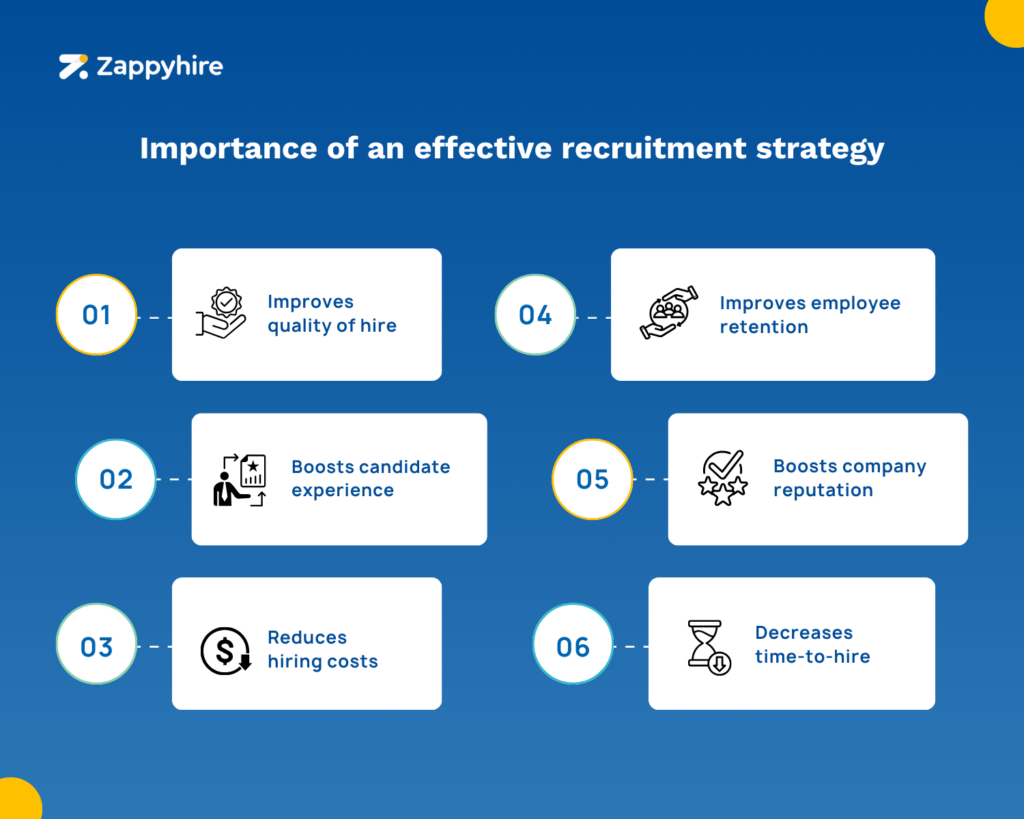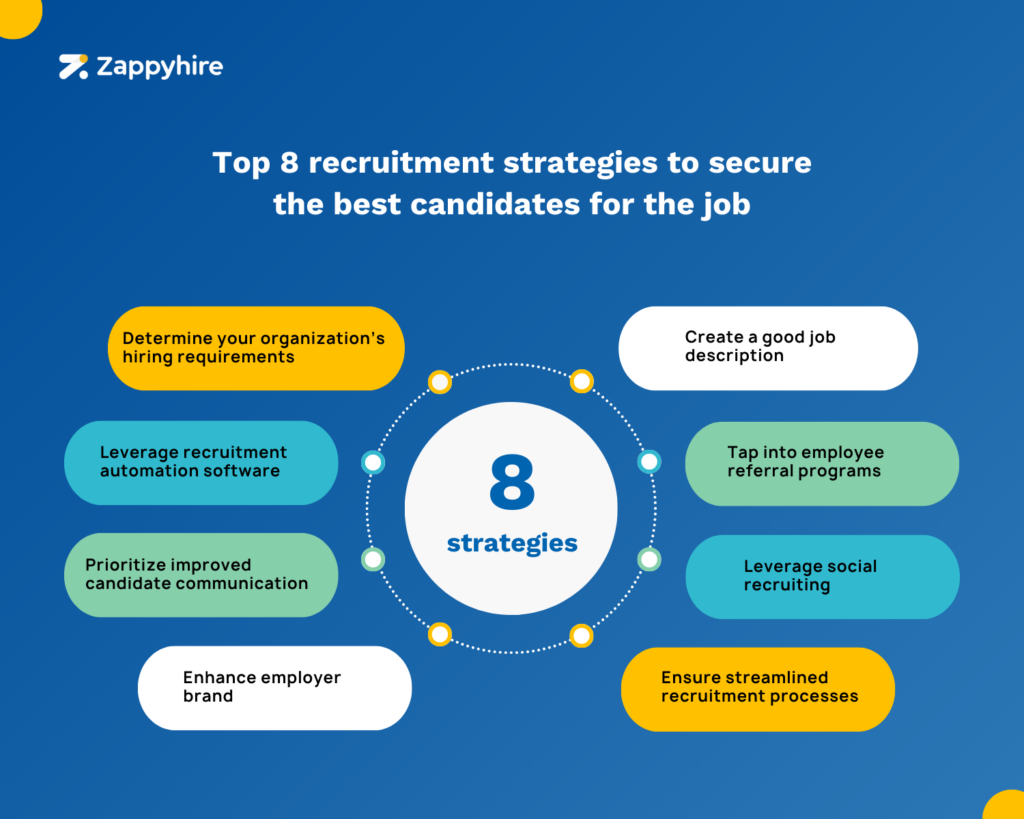
Have you heard? Nearly 77% of employers globally find it challenging to secure skilled talent!
Evidently, there is a shortage of skilled professionals, which also means this shortage is accompanied by fierce competition for top talent.
What this means for you – this tight labor market drastically decreases your chances of recruiting highly skilled professionals who are the right fit for vacant positions at your organization.
The real question is: what are you doing about it?
Here’s our take: you need a repository of the best recruitment strategies that are guaranteed to win you the top talent you’re seeking.
Let’s take a closer look!
What is a recruitment strategy?

Recruitment strategies refer to well laid out action plans that organizations have in place to help them in their quest to successfully identify, attract, and recruit top talent for vacancies.
Formulating and identifying the necessary recruitment strategies involves:
- Assessing the current recruitment operations
- Making inferences
- Identifying gaps and areas for improvement
Organizations must go about formulating them in a way that caters to factors like their present and future hiring needs, the resources they have at their disposal, etc.
Importance of an effective recruitment strategy

Having effective recruitment strategies in place is like having a toolbox filled with a variety of tools, each serving its own purpose, leaving you prepared for any challenge you may encounter.
It is a systematic way of navigating the hiring process, and its importance is evident in the benefits they bring, including the following-
1. Improves quality of hire
Effective recruitment strategies help streamline the recruitment process, resulting in better candidate experiences, more precise skill evaluations, and hence, a stronger alignment with the roles that candidates are hired for.
This significantly improves the quality of hire, enhancing team performance and long-term growth of the organization.
2. Boosts candidate experience
49% of job seekers have declined job offers due to negative recruitment experiences. Therefore, providing exceptional candidate experience is critical to secure the best candidates.
By implementing recruitment strategies that focus on refining every touchpoint in the recruitment lifecycle, organizations can ensure a top-notch experience for the talent they’re eyeing.
3. Decreases time-to-hire
When effective recruitment strategies are implemented with an emphasis on securing top talent, reducing time-to-hire becomes a natural outcome.
These strategies streamline each stage of the recruitment process, allowing organizations to move quickly, stay competitive, and provide a seamless experience to candidates, increasing their chances of acquiring top talent.
4. Reduces hiring costs
Effective recruitment strategies leverage automation to deal with manual and repetitive tasks and streamline processes, reducing overall hiring time. This saves valuable resources, ultimately decreasing hiring costs.
Additionally, these strategies decrease dependencies on third-party agencies, and improve the overall quality of hire because of which organizations experience lower turnover, further decreasing long-term recruitment expenses.
5. Boosts company reputation
Implementing the right hiring strategies improves the efficiency of your hiring processes, helping you deliver a positive candidate experience, supported by clear, timely communication and streamlined procedures.
This prompts your satisfied candidates to advocate for your organization, which strengthens your employer brand and makes you an attractive employer of choice.
6. Improves employee retention
When recruitment strategies are tailored to the specific needs of an organization, they allow recruiters to accurately evaluate candidate skills and help identify the right fit for the role in question.
This congruence between the candidate and the role fosters employee satisfaction, which in turn boosts retention and reduces employee attrition rates.
Top 8 recruitment strategies to secure the best candidates for the job

It is important to note that there isn’t a blanket set of strategies that organizations can adopt.
It’s all about identifying the organization’s unique needs, challenges it’s facing, and selecting the strategies that address specific areas where the recruitment process may be lacking.
Here are the top 8 recruitment strategies we suggest you consider implementing in order to secure your dream employee:
1. Determine your organization’s hiring requirements
First things first. Your organization needs to do its homework to gauge whether a new hire is truly necessary as it’s a costly investment!
Replacement hires are often a given, but the real challenge lies in identifying things like whether or not a team is struggling with workload, for example.
In the same vein, it is crucial to determine if there are skill gaps that a new hire can bridge, if there are future requirements that will demand additional resources, or whether you need to hire at scale.
It’s vital to ascertain “who” you need by sketching out the ideal candidate with the desired skill set and traits, and “what” you need by outlining the role, especially if you’re creating a new position.
2. Create a good job description
You can’t afford to go wrong with this, as the job description is the first direct touchpoint between you and potential candidates.
Clear, crisp, and attractive – these are the traits of an effective job description.
Keeping in view the saying, “the first impression is the best impression”, take a targeted approach to ensure it grabs the attention of the right candidates.
Once you’ve identified your hiring needs, craft a job description that clearly describes the role, responsibilities, and required skills and qualifications, giving applicants a clear picture of what’s expected.
📖 Learn how to create the perfect job description with : The Ultimate Job Description Toolkit
3. Leverage recruitment automation software
With nearly 94% of recruiters agreeing that their ATS has positively impacted their organization’s hiring processes, the value these platforms bring to the table cannot be denied.
Starting from reducing overall hiring time and recruitment costs incurred, to decreasing the recruiter’s workload and improving the candidate experience, they offer numerous benefits that can set you apart from competitors.
They also directly impact the overall quality of hires, enhance candidate sourcing practices, and reduce unconscious bias (important, as 78% of the workforce values DEI).
Additionally, they allow for recruiters to focus on engaging top talent instead of juggling a million repetitive manual tasks that can easily and smartly be automated.
And not to forget, these platforms facilitate data-driven recruitment by providing important insights into the organization’s hiring operations.
📖 Check out : Top 10 AI Recruiting Tools of 2024 for Recruiters
4. Tap into employee referral programs
Just know this about employee referral programs – even though they make up only 7% of applications, they account for a significant 40% of all successful new hires!
Tapping into your employees’ networks is a great way to get closer to top talent, as they’d rightly be able to identify candidates who would be a great fit for your organization and possess the right skills.
It saves time, slashes recruitment costs, and boosts your odds of spotting candidates who are a better fit for the role.
It’s a win-win situation for everyone involved – the employee gets the promised referral bonus, the job seeker gets the desired job, and you get talent that’s vouched for.
5. Prioritize improved candidate communication
46% of talent acquisition leaders report the need for a renewed focus on candidate relationships and 42% say it has become more important to connect with candidates.
This level of connection can be established through timely, personalized communication.
Candidates need to feel respected, like their time is being valued, by receiving personalized updates on how their application is progressing and where they stand.
Keeping candidates in the loop also helps build trust and rapport, which inadvertently strengthens your employer brand.
The biggest win? It reduces candidate drop-offs, helping you retain top talent throughout the hiring process.
6. Leverage social recruiting
On the hunt for the pick of the litter? You’ve got to be where they’re at!
Get this- approximately 86% of job seekers use social media in their job search!
Keep up with the latest trends and leverage social media as a tool to get closer and a better look at your potential candidates (it can help you determine if they’d be a good fit!).
It’s also great for passive recruiting, helping you get in touch with prospective candidates who probably are not actively looking but are open to exploring new opportunities.
Plus, you can use these platforms to showcase your company culture, share employee experiences, and highlight your values, mission and goals.
If these are established on a public platform from the get-go, it can give candidates an idea of whether they’d fit in at your organization or not.
This builds relationships and enhances your employer brand, making your company more attractive to top talent.
📖Further Reading : Social Recruiting Playbook for 2023
7. Enhance employer brand
A lot of the quest to secure the best candidates relies heavily on how your organization is perceived – aka its employer brand.
Don’t believe us? 75% of job seekers consider an employer’s brand before applying for a role.
Landing a job is great, of course, but landing a job at a company that doesn’t meet your expectations and standards can be a nightmare for everyone involved.
That’s why candidates weigh their options through thorough research, and your company’s employer brand plays a critical role in that decision.
So, formulating and implementing strategies to improve your employer brand should be at the top of your list if top talent is what you’re after.
8. Ensure streamlined recruitment processes
By now, you’ve surely picked up on the number one candidate preference – a seamless, hassle-free recruitment process with fewer number of steps, and faster decisions.
To sum it up, candidates want a streamlined recruitment process.
But this is also a win for recruiters, as it significantly eases their workload and helps them better utilize their precious time.
By investing in recruitment automation platforms, standardizing processes, and leveraging data-driven insights to improve shortcomings, organizations can create a more efficient hiring workflow.
Furthermore, eliminating redundant screening rounds and simplifying workflows, can further enhance the recruitment process for all the stakeholders involved.
To sum up

Once you’ve pinpointed the gaps in your existing recruitment operations, it becomes much easier to implement the aforementioned strategies to secure top talent, as you’ll have a better idea of what will work best for your needs.
With all the benefits of having effective recruitment strategies combined, you’ll be well on your way to recruitment success!
Speaking of recruitment success, care to book a demo to see how Zappyhire, the global leader in recruitment automation, can help you win top talent?






